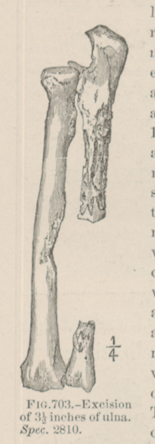Title: McCready, J. S.
Source text: The Medical and Surgical History of the War of the Rebellion. (1861-65.), Part 2, Volume 2 (Washington, DC: Government Printing Office, 1876), 960.
Civil War Washington ID: med.d2e30706
TEI/XML: med.d2e30706.xml
CASE 1918.—Captain J. S. McCready, Co. H, 126th Ohio, aged 35 years, was wounded at Spottsylvania, May 10, 1864, and admitted to Emory Hospital, Washington, on the 17th. Surgeon N. R. Moseley, U. S. V., reported: "Gunshot wound of left forearm at middle third; a minié ball passed from without inward, fracturing the ulna and lacerating the radial artery. May 19th, secondary hæmorrhage occurred from radial artery, which rendered ligation necessary; ten ounces of blood lost. 20th, hæmorrhage recurred; temporarily arrested by compression; eight ounces of blood lost. Surgeon Moseley ligated radial artery at cardiac and at distal extremities, and also resected four inches of ulna at middle third. Constitutional state of patient at time of operation favorable; arm kept in situ by splint and roller. June 1st, patient doing well; hæmorrhage has not recurred. 15th, pyæmia set in; hæmorrhage recurred, eight ounces of blood lost. 22d, four ounces of blood lost; tonic and stimulant treatment. 27th, eight ounces of blood lost; patient still suffering from pyæmia. Hæmorrhage again recurred on the 6th of July; radius and remaining portion of ulna necrosed; soft parts much swollen; sinuses extending to elbow with discharge of dark ichorous pus. Flap amputation of arm at middle third by Surgeon N. R. Moseley, U. S. V.; anæsthetic—sulphuric ether. At time of operation patient much reduced from loss of blood and excessive discharge from wound; pulse 110, weak. Nausea and hiccough, with extreme nervous prostration; treatment, tonics and stimulants with nutritious diet; adhesive straps and cold-water dressings; wound granulating healthily, with copious discharge of laudable pus until July 24th, when the discharge ceased; applied flaxseed poultices. July 31st, discharge reappearing and patient gradually improving." This officer was transferred to the care of Surgeon Thomas Antisell, U. S. V., August 4th, and on the 19th was granted a leave of absence for thirty days to visit his home in Ohio. Surgeon Antisell noted: "Died September 7, 1864, of wounds received in battle." The specimen, represented in the adjoining wood-cut (FIG. 703), was contributed to the Museum by the operator, Dr. Moseley. It consists of "the bones of the left forearm. Three and a half inches from the lowest third of the ulna appears to have been excised. The extremity of the lower fragment is carious, and the upper portion of the shaft is necrosed nearly to the olecranon. A small portion of the inner border of the radius has been absorbed as if after contusion."
